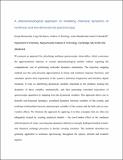| dc.contributor.author | Ramasesha, Krupa | |
| dc.contributor.author | De Marco, Luigi | |
| dc.contributor.author | Horning, Andrew Davis | |
| dc.contributor.author | Mandal, Aritra | |
| dc.contributor.author | Tokmakoff, Andrei | |
| dc.date.accessioned | 2012-10-15T19:48:40Z | |
| dc.date.available | 2012-10-15T19:48:40Z | |
| dc.date.issued | 2012-04 | |
| dc.date.submitted | 2012-01 | |
| dc.identifier.issn | 0021-9606 | |
| dc.identifier.issn | 1089-7690 | |
| dc.identifier.uri | http://hdl.handle.net/1721.1/73991 | |
| dc.description.abstract | We present an approach for calculating nonlinear spectroscopic observables, which overcomes the approximations inherent to current phenomenological models without requiring the computational cost of performing molecular dynamics simulations. The trajectory mapping method uses the semi-classical approximation to linear and nonlinear response functions, and calculates spectra from trajectories of the system's transition frequencies and transition dipole moments. It rests on identifying dynamical variables important to the problem, treating the dynamics of these variables stochastically, and then generating correlated trajectories of spectroscopic quantities by mapping from the dynamical variables. This approach allows one to describe non-Gaussian dynamics, correlated dynamics between variables of the system, and nonlinear relationships between spectroscopic variables of the system and the bath such as non-Condon effects. We illustrate the approach by applying it to three examples that are often not adequately treated by existing analytical models – the non-Condon effect in the nonlinear infrared spectra of water, non-Gaussian dynamics inherent to strongly hydrogen bonded systems, and chemical exchange processes in barrier crossing reactions. The methods described are generally applicable to nonlinear spectroscopy throughout the optical, infrared and terahertz regions. | |
| dc.description.sponsorship | United States. Dept. of Energy (Grant DE-FG02-99ER14988) | en_US |
| dc.language.iso | en_US | |
| dc.publisher | American Institute of Physics (AIP) | en_US |
| dc.relation.isversionof | http://dx.doi.org/10.1063/1.3700718 | en_US |
| dc.rights | Creative Commons Attribution-Noncommercial-Share Alike 3.0 | en_US |
| dc.rights.uri | http://creativecommons.org/licenses/by-nc-sa/3.0/ | en_US |
| dc.source | Prof. Tokmakoff via Erja Kajosalo | en_US |
| dc.title | A phenomenological approach to modeling chemical dynamics in nonlinear and two-dimensional spectroscopy | en_US |
| dc.type | Article | en_US |
| dc.identifier.citation | Ramasesha, Krupa et al. “A Phenomenological Approach to Modeling Chemical Dynamics in Nonlinear and Two-dimensional Spectroscopy.” The Journal of Chemical Physics 136.13 (2012): 134507. Web. | |
| dc.contributor.department | Massachusetts Institute of Technology. Department of Chemistry | en_US |
| dc.contributor.approver | Tokmakoff, Andrei | |
| dc.contributor.mitauthor | Ramasesha, Krupa | |
| dc.contributor.mitauthor | De Marco, Luigi | |
| dc.contributor.mitauthor | Horning, Andrew Davis | |
| dc.contributor.mitauthor | Mandal, Aritra | |
| dc.contributor.mitauthor | Tokmakoff, Andrei | |
| dc.relation.journal | Journal of Chemical Physics | en_US |
| dc.eprint.version | Author's final manuscript | en_US |
| dc.type.uri | http://purl.org/eprint/type/JournalArticle | en_US |
| eprint.status | http://purl.org/eprint/status/PeerReviewed | en_US |
| dspace.orderedauthors | Ramasesha, Krupa; De Marco, Luigi; Horning, Andrew D.; Mandal, Aritra; Tokmakoff, Andrei | en |
| dc.identifier.orcid | https://orcid.org/0000-0002-6101-4145 | |
| mit.license | OPEN_ACCESS_POLICY | en_US |
| mit.metadata.status | Complete | |
